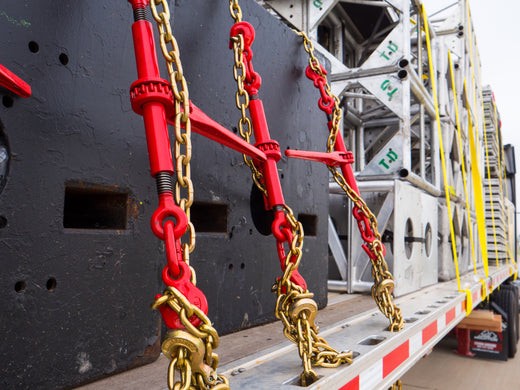
Transport Chain & Load Binders 101
Transport chain and load binders are a staple when it comes to tying down equipment and other heavy cargo. They have the strength needed to securely hold your load in place and get it from Point A to Point B safely, making them a must-have for many in the transportation industry.
Jump to the Information You Need:
- What chain grades are used for tie downs?
- What is grade 70 transport chain?
- How strong is transport chain?
- What is grade 70 chain used for?
- What are load binders?
- How to chain a flatbed load
View / Download this Document as a PDF
What Chain Grades are Used for Tie Downs?
Typically, grade 70 chain is the standard for tie down chain. Other chain grades such as 80, 100, and 120 can also be used, but aren't as popular.
Deciding which chain grade and size you need depends on several factors, but the working load limit is the deciding one – the combined WLL of the chains you use must exceed at least 50% of the total weight of your cargo.
What is Grade 70 Transport Chain?
Made from carbon steel and heat-treated for added strength, grade 70 chain is ideal for cargo transport. Usually available in lengths between 16-25 feet, this chain comes with end hardware like clevis grab hooks, clevis slip hooks, or clevis slip hooks with a latch.
To make it easy to identify, G70 transport chain is embossed with a 7, 70, or 700 and has a yellow chromate finish.
What is Grade 70 Transport Chain Used For?
Along with cargo securement, grade 70 transport chain is frequently used in other industries like logging and towing. It is not suitable for overhead lifting.
How Strong is Transport Chain?
The break strength and working load limit of each chain depends on the chain size and grade. Take a look at the chart below to see the WLL for each.
Chain Working Load Limits by Grade (lbs.)
| Chain Size | Grade 30 | Grade 43 | Grade 70 | Grade 80 | Grade 100 | Grade 120 |
| 1/4" | 1,300 | 2,600 | 3,150 | 3,500 | 4,300 | - |
| 9/32" | - | - | - | - | - | 5,200 |
| 5/16" | 1,900 | 3,900 | 4,700 | 4,500 | 5,700 | 6,600 |
| 3/8" | 2,650 | 5,400 | 6,660 | 7,100 | 8,800 | 10,600 |
| 7/16" | 3,700 | 7,200 | 8,750 | - | - | - |
| 1/2" | 4,500 | 9,200 | 11,300 | 12,000 | 15,000 | 17,900 |
| 5/8" | 6,900 | 13,000 | 15,800 | 18,100 | 22,600 | - |
Grade 70 chain has a load rating that's approximately 20% higher than grade 43 chain, while grades 100 and 120 have a 25 and 50% higher strength than grade 80, respectively. The higher chain grades also offer better resistance to both fatigue and abrasions.
Custom Transport Chain
Looking for a length or chain size we don't offer on our website? Get a custom tie down chain that can be created to perfectly suit your application. Learn more about submitting our online form or browse our FAQ.
Chains vs. Other Tie Downs
There are several other options available for tying down cargo – such as ratchet straps, winch straps, and rope – so why choose transport chain?
Transport chain is incredibly durable when compared to the polyester webbing or rope used for other tie downs. Sharp edges that could cause a winch strap to fray and snap generally won't have any effect on chains.
Additionally, the higher working load limits for chain reduces the amount of tie downs you will need to secure equipment and other heavy loads.
Inspecting Your Transport Chain
Before each use, you should inspect the chain, attachment points, and end hardware for any visible signs of damage or wear.
What Is a Chain Binder?
Chain binders, also known as load binders, are the devices used to adjust your chain's tension. This tightening is what ensures your cargo is held securely in place. They have a tension hook on each end that attaches to your chain and a handle to add tension.
When it comes to choosing the right chain binder for you, you will need to look at both size and style.
Size is easy – you'll need a binder that works with the chain size you are using. At US Cargo Control, the chain size that a binder works with should be clearly stated – but what if you run into an instance where two chain sizes are listed? The first size indicates the compatible grade 70 chain, while the second size indicates the compatible grade 43 chain. For example, the 3/8" – 1/2" ratchet binder is designed to work with 3/8" grade 70 chain and 1/2" grade 43 chain.
Choosing the right style is less straightforward – there are two options, ratchet and lever, and the choice usually depends on a multitude of factors. However, a ratchet binder is generally regarded as the safer option. Watch the video below or continue reading to learn more about each style.
Ratchet Load Binders
A ratchet binder uses a ratcheting mechanism to add tension to your chain. This device lessens the amount of force needed, reducing the risk of the bar snapping back at you and making it easier to tighten.
The additional parts - including a cam and prawl apparatus - provide a smooth ratcheting action but result in the load binder taking longer to install and release. Many find that an acceptable trade for increased safety.
Lever Binders
Lever load binders, on the other hand, require additional strength because they store energy in the handle. This often leads to people using cheater bars, but these bars are dangerous and not recommended.
It has fewer parts than a ratchet binder, so it's easier to install.
Tips for How to Use Lever Chain Binders
If you are going to use a lever binder, we have a few tips that can help keep you safe.
- Only one person should operate a lever binder
- Make sure you have secure footing on the ground before starting to tighten
- Always tighten by hand and wear gloves for a better grip
Learn more about the differences between ratchet and lever binders.
Using Load Binders
See a ratchet binder in action and learn more about the different styles in the video below.
How to Chain a Flatbed Load
Using chain binders to tie down heavy cargo is dependent on factors like cargo length, width, and type. For example, according to the FMCSA, loads that are 5' or less require just one tie down, while those between 5' and 10' require two. If the weight of this load is more than 1,100 lbs., then it will need two tie downs regardless of length.







